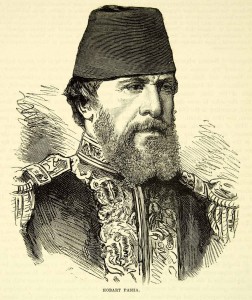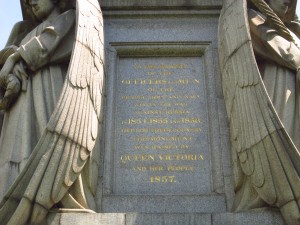
A visit to two deceased forefathers in the shadow of the Crimean War Memorial in Istanbul Up till now, almost all of my posts on this website have concerned members of the Champion and Walker sides of my family, but today I had the moving experience of visiting the graves of two ancestors/relatives from my grandmother's side. I refer to Julia (Judy) Stewart, wife of F W Champion, the tiger conservationist and photographer. Her mother, Frances Jane Hobart Hampden, wife of Major-General Sir Keith Stewart KCB DSO, was niece of an outstanding but largely, and undeservedly, forgotten character, "Augustus Charles Hobart Hampden, who was born in Leicestershire, the third son of the 6th Earl of Buckinghamshire. In 1835 he entered the Royal Navy and served as a midshipman on the coast of Brazil in the suppression of the slave trade, displaying much gallantry in the operations. In 1855 he took part, as captain of HMS Driver, in the Baltic Expedition, and was actively engaged at Bomarsund and Åbo. In 1862 he retired from the navy with the rank of post-captain, but his love of adventure led him, during the American Civil War, to take the command of a blockade runner. He had the good fortune to run the blockade eighteen times, conveying war material to Charleston and returning with a cargo of cotton. In 1867 Hobart entered the Ottoman service, and was immediately nominated to the command of that fleet, with the rank of "Bahriye Livasi" (Rear-Admiral). In this capacity he performed splendid service in helping to suppress the insurrection in Crete, and was rewarded by the Sultan with the title of Pasha (1869). In 1874 Hobart, whose name had, on representations made by Greece, been removed from the British Royal Navy List, was reinstated; his restoration did not, however, last long, for on the outbreak of the Russo-Turkish war he again entered Ottoman service. On the conclusion of peace Hobart still remained in the Ottoman service, and in 1881 was appointed Mushir, or marshal, being the first Christian to hold that high office. He died at Milan on 19 June 1886" (Wikipedia), but his body was returned to Constantinople (Istanbul today), and he now lies in the Haydar Pasha British cemetery. The following link leads to a much more detailed description of this extraordinary man's colourful, swashbuckling life: http://dawlishchronicles.com/hobart-pasha-forgotten-victorian-hero/
The other grave I hoped to find was that of another enterprising ancestor of my grandmother's, Lt-Col Patrick Stewart CB, who among many other feats was Director-General of the Indo-European Telegraph, the first cable connection between Great Britain and India, but who died at the age of 32. One of the first messages sent down the newly completed line was that announcing his early death, and he now lies within fifty yards of the splendid Crimean War Memorial, erected by Queen Victoria in 1857, which also hosts the commemorative plaque to Florence Nightingale, who saved so many lives and tended so many wounded in her makeshift hospital in the nearby Selimiye Barracks.
With such forefathers to visit, I set off by ferry across the Bosphorus, and passed by the gutted wreckage of the neoclassical Haydarpaşa Station building, a gift to the Sultan from Kaiser Wilhelm II, which was built between 1906 and 1908. Its foundation is 1100 wooden piles, each 21 metres (69 feet) long, driven into the ground by steam hammer. Haydarpaşa was an important link in the railway chain of the Kaiser's Berlin-to-Baghdad railway scheme, part of the German Empire's strategic Drang nach Osten ("Drive to the East") during the later 19th century. (ref Turkey Travel Planner). The roof and top floor were burned in an accidental fire in 2010, and it is uncertain whether it will ever be restored.
 The gutted shell of the former Haydarpaşa station
The gutted shell of the former Haydarpaşa station
I then walked from the ferry port, passing by a large closed military installation, eventually finding the rather inconspicuous entrance to the Haydar Pasha British cemetery down a side street, and almost the first grave I came upon was that of Patrick Stewart, and it was indeed close to the splendid Crimean War Memorial. A more detailed description of Patrick Stewart's outstandingly exciting and productive life can be found by clicking on the following link: http://atlantic-cable.com/CablePioneers/Stewart/
 The grave of Patrick Stewart, my great great great uncle
The grave of Patrick Stewart, my great great great uncle
 How poignant that this extraordinarily talented man should have died so young
How poignant that this extraordinarily talented man should have died so young
 Patrick Stewart's grave is close by the splendid memorial to the Crimean War dead
Patrick Stewart's grave is close by the splendid memorial to the Crimean War dead
Hobart Pasha was more difficult to locate, as he lies in a more densely 'populated' section of the cemetery, and it took me perhaps half an hour to find his grave, but finally I located it, and paid my respects to the second of my two forebears who lie in that tranquil oasis of peace and greenery, tended as usual beautifully by the Commonwealth War Graves Commission.
 Hobart Pasha's grave was more difficult to locate, surrounded as it is by other similar tombstones
Hobart Pasha's grave was more difficult to locate, surrounded as it is by other similar tombstones
 The Haydar Pasha Cemetery is beautifully tended by the Commonwealth War Graves Commission
The Haydar Pasha Cemetery is beautifully tended by the Commonwealth War Graves Commission















